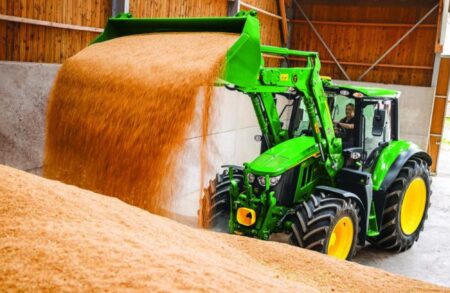By John Hult
Very little of South Dakota’s corn is used to produce sweetened beverages, but the crop’s boosters in the state say a nationwide shift toward cane sugar is an unwelcome sign for corn farmers.
Coca-Cola announced its intention to offer cane sugar-sweetened beverages this week. The company said its new beverages are “designed to complement the company’s strong core portfolio,” rather than replace its regular products, which are sweetened by high-fructose corn syrup.
The announcement during the company’s second-quarter earnings report confirmed a decision President Donald Trump talked about on Truth Social, his own social media platform. Robert F. Kennedy Jr., Trump’s secretary of Health and Human Services, has blamed the widely used corn-based sweetener for contributing to a U.S. obesity epidemic.
Cane sugar and high-fructose corn syrup are nutritionally interchangeable, according to the American Medical Association and most scientific studies on the topic. But concerns about the syrup’s status as a processed food product from high-profile advocates, including from Kennedy during his former career as an author and activist, have helped push consumer sentiment toward cane sugar.
Mexico, the United Kingdom, Spain, and France are among the countries where Coca-Cola is sweetened with cane sugar.
Syrup’s Place in the Corn Market
Farmers in the U.S. plant more than 90 million acres of corn a year, but only 3-4% is refined to produce high-fructose corn syrup for use in everything from beverages to breads.
That’s significant enough to rankle corn groups nationally. The Corn Refiners Association responded to Trump’s announcement by saying the move would hurt U.S. farmers and lead to a loss of manufacturing jobs.
South Dakota produced the sixth-largest corn harvest in the U.S. in 2024, but its corn crop is less likely than most to be turned into syrup. Most South Dakota corn is used for ethanol and livestock feed. There are no “wet mills” in the state for syrup production, said DaNita Murray, executive director of the trade group South Dakota Corn.
Even so, Murray calls the move from Coca-Cola “a marketing decision” that throws the health value of her organization’s commodity into question, and potentially pushes down demand for it.
“We firmly believe that demand is demand, and we don’t like the accusation that we’re raising poison,” Murray said.
Changes to demand could ultimately impact South Dakota producers, Murray said, particularly if the U.S. were to follow the lead of some other countries and restrict the use of high-fructose corn syrup. Congresswoman Anna Paulina Luna, R-Florida, introduced legislation last year that would ban the product.
Murray pointed to industry-funded research from North Dakota State University that concluded such a scenario would lead to a price decline for corn of 15–34¢ per bushel, with associated reductions in corn cash receipts estimated between $2.2 billion and $5.1 billion.
Under that hypothetical scenario, South Dakota’s local corn prices would suffer, Murray said.
South Dakota Immediate Impacts: Perception More Than Prices
That’s an important point for Doug Sombke of the South Dakota Farmers Union. He’s not so sure a dip in demand for corn from a loss of corn syrup production would make much of a difference.
The price of corn is always a concern, Sombke said, but he doesn’t see corn syrup usage as making even a penny’s difference per bushel unless something radical happens.
“Really, in the grand scheme of things, for the family farmer, it’s so small,” Sombke said.
Sombke would like to see more ethanol production and more diversity in farm operations and crops in the field. The price of corn hasn’t kept pace with the cost of doing business, he said, even as high fructose corn syrup has proliferated across the U.S. food system.
Sombke sees the fight over cane sugar as one focused more on the commodity than the producer. In the U.S., cane sugar production is centered in southern states like Florida, Georgia, and Louisiana.
“This is cane versus corn,” Sombke said.
Corn has advantages in that fight, according to Jim Ketelhut, president of the South Dakota Corn Utilization Council. He isn’t worried about an immediate impact to prices, but said it’s unfortunate that corn has “gotten a black eye” in the public consciousness.
The switch from cane sugar to corn syrup decades ago was a matter of price and utility, he said. If “sugar is sugar,” as Ketelhut put it, there’s little but extra cost to be gained by a shift away from corn syrup.
“The reason it’s used so much is that it’s highly available, and it’s economical for the end users,” Ketelhut said. “Those are the good things nobody talks about.”
South Dakota Searchlight launched in 2022. The Searchlight is an affiliate of States Newsroom, the nation’s largest state-focused nonprofit news organization, supported by grants and donations. The staff of the Searchlight retains full editorial independence.


:max_bytes(150000):strip_icc()/CaseCombineHarvestingOnHill-WideShot-2-2000-5323a1ed14634f679027e940a1e80c70.jpg)
:max_bytes(150000):strip_icc()/Lee20Combine-2000-74f4b0472e2f4244a50679f9d4febb2f.jpeg)
:max_bytes(150000):strip_icc()/CaseCombineAndTractorHarvesting2-WideShot-2000-300009fbd0da4f08ac67aee726a10e90.jpg)


:max_bytes(150000):strip_icc()/101088351_corn-6e630ca8c4d0405c8494114b107e18bb.jpg)


:max_bytes(150000):strip_icc()/Markets-9-Corn-down-wheat-down-5-255020c945814214a487a11b89b5066b.jpeg)